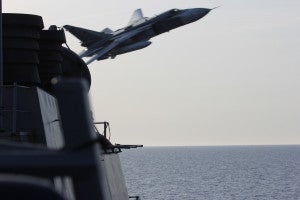
Why should the Russians be afraid of push back from the progressive socialists that control the United States? All of the signals that Mr Ogbjma has given that part of the world is 'go ahead and do what ever you want, I don't care. I have no intention of doing anything that would stand in the way of Russian or Chinese aggression'.
Its the ideology and agenda of Mr Ogbjma, America is a bad country and I will amend our past history of aggression and greed with cowardice.
Our enemies love Mr Ogbjma.
Failed Obama ‘Reset’ Has Encouraged Russian Aggression
Peter Brookes / @Brookes_Peter /
People seem a bit surprised—even perplexed—by the breathless news reports and video of Russian warplanes “buzzing” an American warship operating in international waters in the Baltic Sea this week. The reality is that they shouldn’t be. That, of course, isn’t to say that we shouldn’t be deeply troubled for the safety of our sailors on the USS Donald Cook at the hands of some “hot dog” Russian pilots involved in reckless and provocative actions that could have had dire and or unintended consequences.
But, that said, there’s a method to Moscow’s madness. First, there’s the matter of geography. The Baltic Sea has long been a Russian security priority. For instance, the Baltic waters lap up against the Russian coast at the iconic city of St. Petersburg (once Leningrad), where a successful invading force could drive into the heart of Russia, including reaching Moscow.
During the Cold War, the Soviet Union controlled the southern Baltic Sea coastline from Russia through the Baltic States (Latvia, Lithuania and Estonia), across Poland and into East Germany. In Moscow’s eyes at that time, the Baltic Sea should be a Soviet “lake.” Today, rather than lined with Soviet Republics and loyal members of the Warsaw Pact, that same coastline is instead populated with NATO states with rough relations with the Russians. That’s not at all comforting to Kremlin & Co. The only section of the southern Baltic Coast that isn’t part of NATO is Kaliningrad, a Russia-controlled outpost between Poland and Lithuania that Russia sees as not only isolated and vulnerable, but strategic to Russian security.
Indeed, after the less-than-stellar response to the Crimea crisis, there’s been a constant concern among some that Moscow might try to carve out a Russian-controlled access route to Kaliningrad through NATO member Lithuania Of course, taking on NATO is different than taking on Ukraine.
Second, the Russian show of force in the Baltic is meant to send a signal of strength in response to perceptions of American weakness, resulting largely from the White House’s failed “reset” policy toward the Kremlin, going back to 2009. In fact, concerns about Russian aggression in the Baltics and Eastern Europe along NATO’s eastern flank have caused the Pentagon to rotate a Brigade Combat Team (BCT) back to Europe under the European Reassurance Initiative. This effort involves several thousand U.S. soldiers, a couple hundred tanks, armored vehicles and artillery pieces that will join 60,000-plus of America’s bravest already in Europe. U.S. pre-positioned weapons stockpiles will also be improved.
The returning American BCT will be forward-deployed along NATO’s eastern flank to frontline states including Lithuania, Latvia, Estonia, Poland, Romania and Bulgaria.It’s a good move, but is it enough?
Not surprisingly, Russia isn’t happy about the U.S.-NATO moves and has promised an “asymmetric response,” which may include this week’s dangerous fly-bys of the Russian Su-24 Fencers against the USS Donald Cook in the Baltic. More Moscow mischief may be in the offing.
Sure, Russia could get more feisty, but considering the failure of the White House’s “reset” policy toward the Kremlin so far, it’s probably time for a serious change toward Russia—one that comes from a position of strength.

No comments:
Post a Comment